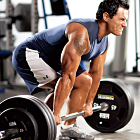 Q: What do you think about using the Olympic press rather than the jerk as overhead work for athletes—because it’s such an easier exercise to master compared to the jerk?
Q: What do you think about using the Olympic press rather than the jerk as overhead work for athletes—because it’s such an easier exercise to master compared to the jerk?
A: Whoa! If you’ve followed the sport of weightlifting, you’ll understand that by the time the Olympic press was taken out of competition after the ’72 Olympics, it had become an extremely technical exercise that favored quick athletes.
In the early days of weightlifting, however, the snatch and clean and jerk were considered “quick lifts,” in contrast to the Olympic press, which was considered a test of absolute strength at that time. Presses were performed extremely strictly and relied mainly on tremendous shoulder and triceps strength—until the rules relaxed and the game changed.
Although it’s difficult to determine who invented the modern Olympic press, the United States lifter who is often credited with introducing it there is Tony Garcy. Garcy represented the U.S. in the ’60 and ’64 Olympic Games and broke American records in the press in both the 148- and 165-pound bodyweight divisions.
In performing the modern Olympic press, after cleaning the weight, you had to assume an upright position with your legs straight. At that point the referee would give the signal to begin the press. You would lean back, explosively whip the weight up with the strength of your abdominals and hip flexors, and then lean back again—a whipping movement that could be described as a slingshot. That technique enabled you to drive the weight more easily through the sticking point.
The modern Olympic press was a difficult technique to master, but it led to more frequent record breaking over the years. In 1936 the 300-pound barrier was broken in the press by German heavyweight Sepp Manger, and 19 years later Paul Anderson exceeded the 400-pound mark. In 1962 the record was held by Russia’s Yury Vlasov at 410. Other lifters continued to break records in the Olympic press, and just 10 years later the great Vasily Alexeev increased the record by 121 pounds! Likewise, in the 198-pound class the record was 351.5 pounds in 1962, made by Russia’s Vasily Stepanovs, but 10 years later his comrade David Rigert kicked that up 85 pounds with a best of 436.5 pounds. In contrast, increases in the jerk record came slowly; in the same 10-year period the record rose by only 39.5 pounds in the 198-pound class and by 59.5 pounds in the superheavyweight class.
To answer your question, the Olympic press is a good exercise that gives you a lot of “bang for your buck,” but a competitive weightlifter should not specialize on it because the timing is different from that of the clean and jerk. As a general guideline, weightlifters should be able to overhead-press about 48 to 52 percent of their best jerk.
Editor’s note: Charles Poliquin is recognized as one of the world’s most successful strength coaches, having coached Olympic medalists in 12 different sports, including the U.S. women’s track-and-field team for the 2000 Olympics. He’s spent years researching European journals (he’s fluent in English, French and German) and speaking with other coaches and scientists in his quest to optimize training methods. For more on his books, seminars and methods, visit www.CharlesPoliquin.com. IM





















You must be logged in to post a comment Login